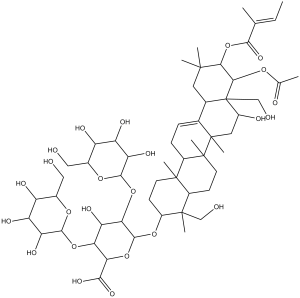Sapogenins glycosides are a mixture of triterpene and steroid saponins isolated from medicinal plants such as Aesculus hippocastanum L., Hedera helix L. and Ruscus aculeatus L., which are claimed to be effective for the treatment/prevention of venous insufficiency. Sapogenins are the aglycones, or non-saccharide, portions of the family of natural products known as saponins. They may non-competitively inhibit hyaluronidase and elastase activities.
Physicochemical Properties
| Molecular Formula | C58H94O27 | |
| Molecular Weight | 1223.3 | |
| Exact Mass | 1643.942 | |
| CAS # | 8047-15-2 | |
| Related CAS # |
|
|
| PubChem CID | 198016 | |
| Appearance | Light yellow to yellow solid powder | |
| Density | 1.2±0.1 g/cm3 | |
| Melting Point | 158℃ | |
| Index of Refraction | 1.583 | |
| LogP | 28.57 | |
| Hydrogen Bond Donor Count | 15 | |
| Hydrogen Bond Acceptor Count | 27 | |
| Rotatable Bond Count | 14 | |
| Heavy Atom Count | 85 | |
| Complexity | 2340 | |
| Defined Atom Stereocenter Count | 31 | |
| SMILES | C[C@]1(CCC23COC4([C@H]2C1)CC[C@@H]5[C@]6(CC[C@@H](C(C6CC[C@]5([C@@]4(C[C@H]3O)C)C)(C)C)O[C@H]7[C@@H]([C@H]([C@H](CO7)O[C@H]8[C@@H]([C@H]([C@@H](CO8)O)O)O)O[C@@H]9[C@@H]([C@H]([C@@H]([C@H](O9)CO)O)O)O)O[C@H]1[C@@H]([C@H]([C@@H]([C@H](O1)CO)O)O)O[C@@H]1[C@@H]([C@H]([C@@H]([C@H](O1)CO)O)O)O)C)C=O |
|
| InChi Key | MAEBCGDGGATMSC-OSHGGGOQSA-N | |
| InChi Code | InChI=1S/C58H94O27/c1-52(2)29-7-11-55(5)30(8-12-58-31-15-53(3,22-62)13-14-57(31,23-77-58)32(64)16-56(55,58)6)54(29,4)10-9-33(52)82-50-46(85-51-45(40(71)37(68)27(19-61)80-51)84-49-43(74)39(70)36(67)26(18-60)79-49)44(83-48-42(73)38(69)35(66)25(17-59)78-48)28(21-76-50)81-47-41(72)34(65)24(63)20-75-47/h22,24-51,59-61,63-74H,7-21,23H2,1-6H3/t24-,25-,26-,27-,28+,29?,30-,31+,32-,33+,34+,35-,36-,37-,38+,39+,40+,41-,42-,43-,44+,45-,46-,47+,48-,49-,50+,51+,53-,54+,55-,56+,57?,58?/m1/s1 | |
| Chemical Name | (2R,4S,5R,10S,13R,14R,18S,20R)-10-[(2S,3R,4S,5S)-3-[(2S,3R,4S,5S,6R)-4,5-dihydroxy-6-(hydroxymethyl)-3-[(2R,3R,4S,5S,6R)-3,4,5-trihydroxy-6-(hydroxymethyl)oxan-2-yl]oxyoxan-2-yl]oxy-4-[(2R,3R,4S,5S,6R)-3,4,5-trihydroxy-6-(hydroxymethyl)oxan-2-yl]oxy-5-[(2S,3R,4S,5R)-3,4,5-trihydroxyoxan-2-yl]oxyoxan-2-yl]oxy-2-hydroxy-4,5,9,9,13,20-hexamethyl-24-oxahexacyclo[15.5.2.01,18.04,17.05,14.08,13]tetracosane-20-carbaldehyde | |
| Synonyms | SAPONIN; NSC 104795; NSC-135029; BRN 0078682; | |
| HS Tariff Code | 2934.99.9001 | |
| Storage |
Powder-20°C 3 years 4°C 2 years In solvent -80°C 6 months -20°C 1 month |
|
| Shipping Condition | Room temperature (This product is stable at ambient temperature for a few days during ordinary shipping and time spent in Customs) |
Biological Activity
| ln Vitro | Glycosides possessing a unique foaming property are called saponins. Saponins are made up of an ether bond to a sugar side chain and a polycyclic aglycone, which can be either a triterpenoid or a choline steroid connected via C3. The nonpolar sapogenin and the water soluble side chain work together to give a saponin its foaming properties.Because saponins are bitter, they make animal feed less palatable. While some saponins are not very harmful, others cause nonruminant animals to consume less feed and grow more slowly. For instance, the saponins in spinach and oats help the body absorb calcium and silicon more quickly, which aids in digestion. Some pasture weeds are extremely toxic to some animal species and contain significant amounts of hazardous saponins[1]. | ||
| ln Vivo |
|
||
| Animal Protocol |
|
||
| Toxicity/Toxicokinetics |
Toxicity Data LCLo (rat) = 250 mg/m3/4hr |
||
| References | Arch Pharm (Weinheim).1995 Oct;328(10):720-4. | ||
| Additional Infomation |
Saponin has been reported in Streptomyces, Trigonella foenum-graecum, and Saponaria officinalis with data available. A type of glycoside widely distributed in plants. Each consists of a sapogenin as the aglycone moiety, and a sugar. The sapogenin may be a steroid or a triterpene and the sugar may be glucose, galactose, a pentose, or a methylpentose. See also: Cyclamin (annotation moved to). |
Solubility Data
| Solubility (In Vitro) |
Ethanol : ~100 mg/mL H2O : ~33.33 mg/mL |
| Solubility (In Vivo) |
Solubility in Formulation 1: 6.25 mg/mL (Infinity mM) in PBS (add these co-solvents sequentially from left to right, and one by one), clear solution; with sonication (<60°C). Solubility in Formulation 2: PBS: 6.25 mg/mL (Infinity mM) (Please use freshly prepared in vivo formulations for optimal results.) |
| Preparing Stock Solutions | 1 mg | 5 mg | 10 mg | |
| 1 mM | 0.8175 mL | 4.0873 mL | 8.1746 mL | |
| 5 mM | 0.1635 mL | 0.8175 mL | 1.6349 mL | |
| 10 mM | 0.0817 mL | 0.4087 mL | 0.8175 mL |
